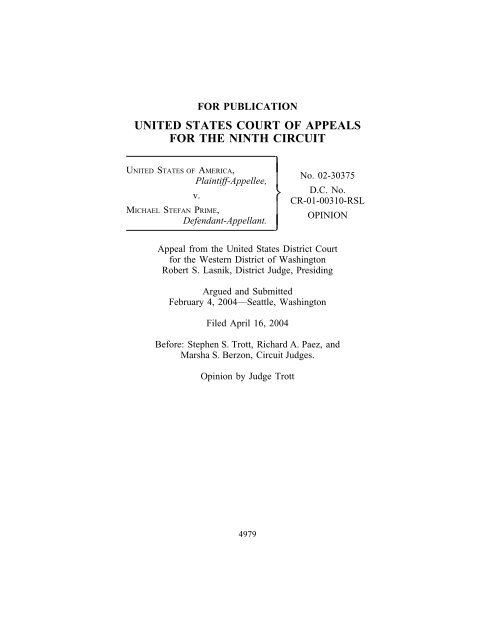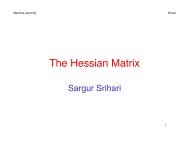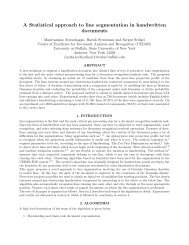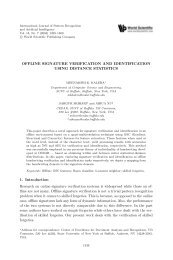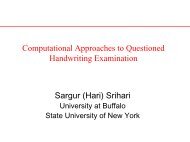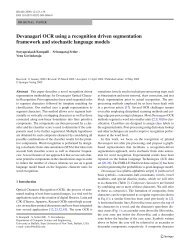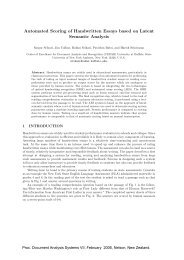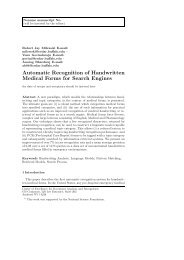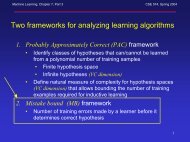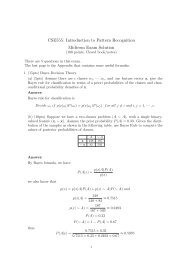United States of America v. Michael Stefan Prime - CEDAR
United States of America v. Michael Stefan Prime - CEDAR
United States of America v. Michael Stefan Prime - CEDAR
Create successful ePaper yourself
Turn your PDF publications into a flip-book with our unique Google optimized e-Paper software.
FOR PUBLICATIONUNITED STATES COURT OF APPEALSFOR THE NINTH CIRCUITUNITED STATES OF AMERICA,MICHAEL STEFAN PRIME,⎫No. 02-30375Plaintiff-Appellee,D.C. No.v. ⎬ CR-01-00310-RSLDefendant-Appellant.⎭OPINIONAppeal from the <strong>United</strong> <strong>States</strong> District Courtfor the Western District <strong>of</strong> WashingtonRobert S. Lasnik, District Judge, PresidingArgued and SubmittedFebruary 4, 2004—Seattle, WashingtonFiled April 16, 2004Before: Stephen S. Trott, Richard A. Paez, andMarsha S. Berzon, Circuit Judges.Opinion by Judge Trott4979
4982 UNITED STATES v. PRIMECOUNSELAnna M. Tolin, Siderius Lonergan & Martin, Seattle, Washington,for the defendant-appellant.<strong>Michael</strong> T. Sennott, Siderius Lonergan & Martin, Seattle,Washington, for the defendant-appellant.Bruce F. Miyake, Assistant <strong>United</strong> <strong>States</strong> Attorney, Seattle,Washington, for the plaintiff-appellee.TROTT, Circuit Judge:OPINIONIOVERVIEW<strong>Michael</strong> <strong>Prime</strong> (“<strong>Prime</strong>”) was charged with, and convicted<strong>of</strong>, one count <strong>of</strong> conspiracy to commit wire fraud, in violation
UNITED STATES v. PRIME<strong>of</strong> 18 U.S.C. § 371; one count <strong>of</strong> conspiracy to manufacturecounterfeit securities, in violation <strong>of</strong> 18 U.S.C. § 371; andthree counts <strong>of</strong> possessing, manufacturing, and uttering counterfeitsecurities, in violation <strong>of</strong> 18 U.S.C. § 513(a). <strong>Prime</strong>raises four issues on appeal: 1) whether the district court properlydenied his motion for a Franks hearing; 1 2) whether thecourt abused its discretion in allowing the testimony <strong>of</strong> anexpert handwriting analyst; 3) whether the court abused itsdiscretion in not allowing <strong>Prime</strong> to substitute counsel; and 4)whether the jury’s potential exposure to extrinsic evidencewas grounds for a new trial. We have jurisdiction under 28U.S.C. § 1291, and we affirm all <strong>of</strong> the district court’s ordersand decisions.IIBACKGROUND4983Between April and June 2001, <strong>Prime</strong>, along with three coconspirators,David Hiestand (“Hiestand”), Juan Ore-Lovera,and Jeffrey Hardy, sold non-existent items on eBay, purchaseditems using counterfeit money orders created by thegroup, sold pirated computer s<strong>of</strong>tware, and stole credit cardnumbers from s<strong>of</strong>tware purchasers. To facilitate this operation,<strong>Prime</strong> and his cohorts used a credit card encoder to inputthe stolen data on their own credit cards, set up post <strong>of</strong>ficeboxes under false names, manufactured false identifications,and used a filter bank account to hide proceeds <strong>of</strong> the crimes.1 In order to receive a Franks hearing, the defendant must make a nonconclusoryand “ ‘substantial preliminary showing’ that the affidavit containedactual falsity, and that the falsity either was deliberate or resultedfrom reckless disregard for the truth.” <strong>United</strong> <strong>States</strong> v. Chesher, 678 F.2d1353, 1360 (9th Cir. 1982) (citing Franks v. Delaware, 438 U.S. 154, 171(1978)). There is no evidence that the immaterial inaccuracies containedin the affidavit were either deliberate or made with reckless disregard forthe truth, and thus this issue on appeal is without merit.
4984 UNITED STATES v. PRIMEAt trial, numerous victims testified as to the details surroundinghow they had been defrauded by <strong>Prime</strong>’s variousscams. In addition, co-conspirators Hiestand and Hardy bothextensively testified as to the details <strong>of</strong> the conspiracy, implicating<strong>Prime</strong> in all <strong>of</strong> the crimes charged. The prosecutionalso elicited the expert opinion <strong>of</strong> Kathleen Storer (“Storer”),a forensic document examiner with the Secret Service. Shetestified that <strong>Prime</strong> was the author <strong>of</strong> as many as thirty-eightincriminating exhibits, including envelopes, postal forms,money orders, Post-it notes, express mail labels and postalbox applications. <strong>Prime</strong> took the stand in his own defense andclaimed that despite all <strong>of</strong> the evidence linking him to the variousscams, including admissions that his fingerprints were onseveral items linked to the crimes, he was simply attemptingto engage in legal entrepreneurial ventures. <strong>Prime</strong> also confirmedthat he had previously been convicted <strong>of</strong> first and seconddegree theft, two counts <strong>of</strong> possession <strong>of</strong> stolen propertyin the second degree, and forgery. The jury found <strong>Prime</strong>guilty on all counts.<strong>Prime</strong> moved for a new trial based on the improper submission<strong>of</strong> extrinsic evidence to the jury. The district court deniedthe motion, and this appeal follows.IIIADMISSIBILITY OF EXPERT TESTIMONY<strong>Prime</strong> moved in limine to exclude Storer’s expert testimony.The court held a Daubert hearing where both sideswere allowed to <strong>of</strong>fer voluminous materials and expert testimonyregarding the reliability <strong>of</strong> the proposed testimony.Daubert v. Merrell Dow Pharms., Inc., 509 U.S. 579 (1993).After careful consideration, the court denied the motion, see<strong>United</strong> <strong>States</strong> v. <strong>Prime</strong>, 220 F. Supp. 2d 1203 (W.D. Wash.2002), and Storer testified that, in her opinion, <strong>Prime</strong>’s handwritingappeared on counterfeit money orders and otherincriminating documents. On appeal, <strong>Prime</strong> contends that the
admission <strong>of</strong> expert testimony regarding handwriting analysiswas unreliable under Daubert, and thus the court abused itsdiscretion by allowing Storer to testify.Handwriting AnalysisUNITED STATES v. PRIME4985[1] In Daubert, the Supreme Court set forth the guidingprinciple that “under [Federal Rule <strong>of</strong> Evidence 702] 2 the trialjudge must ensure that any and all scientific testimony or evidenceadmitted is not only relevant, but reliable.” 509 U.S. at589. In order to assist the trial courts with this task, the Courtsuggested a flexible, factor-based approach to analyzing thereliability <strong>of</strong> expert testimony. Id. at 593-95. Although not anexclusive list, these factors include: 1) whether a method canor has been tested; 2) the known or potential rate <strong>of</strong> error; 3)whether the methods have been subjected to peer review; 4)whether there are standards controlling the technique’s operation;and 5) the general acceptance <strong>of</strong> the method within therelevant community. Id. at 593-94.[2] Kumho Tire Co. v. Carmichael resolved any post-Daubert uncertainty that the trial judge’s responsibility tokeep unreliable expert testimony from the jury applies notonly to “scientific” testimony, but to all expert testimony. 526U.S. 137, 148 (1999). As a result, this “basic gatekeepingobligation” applies with equal force in cases, such as this one,where “non-scientific” experts wish to relate specializedobservations derived from knowledge and experience that isforeign to most jurors. Id. Kumho Tire also makes it clear that“the trial judge must have considerable leeway in deciding ina particular case how to go about determining whether particularexpert testimony is reliable,” as well as the ultimate2 “If scientific, technical, or other specialized knowledge will assist thetrier <strong>of</strong> fact to understand the evidence or to determine a fact in issue, awitness qualified as an expert by knowledge, skill, experience, training, oreducation, may testify thereto in the form <strong>of</strong> an opinion or otherwise . . .”FED. R. EVID. 702.
4986 UNITED STATES v. PRIMEdetermination <strong>of</strong> whether the proposed expert testimony isreliable. Id. at 152. Accordingly, we review the district court’sdecision to admit or deny expert testimony for abuse <strong>of</strong> discretion.Id.In accordance with Kumho Tire, the broad discretion andflexibility given to trial judges to determine how and to whatdegree these factors should be used to evaluate the reliability<strong>of</strong> expert testimony dictate a case-by-case review rather thana general pronouncement that in this Circuit handwriting analysisis reliable. As the Supreme Court concluded,we can neither rule out, nor rule in, for all cases andfor all time the applicability <strong>of</strong> the factors mentionedin Daubert, nor can we now do so for subsets <strong>of</strong>cases categorized by category <strong>of</strong> expert or by kind <strong>of</strong>evidence. Too much depends upon the particular circumstances<strong>of</strong> the particular case at issue.Id. at 150; see also <strong>United</strong> <strong>States</strong> v. Hankey, 203 F.3d 1160,1168 (9th Cir. 2000) (quoting Skidmore v. Precision Printingand Packaging, Inc., 188 F.3d 606, 618 (5th Cir. 1999)(“Whether Daubert’s suggested indicia <strong>of</strong> reliability apply toany given testimony depends on the nature <strong>of</strong> the issue athand, the witness’s particular expertise, and the subject <strong>of</strong> thetestimony. It is a fact-specific inquiry.”) (internal citationsomitted)).In this case, Storer was given 112 pages <strong>of</strong> writing knownto be <strong>Prime</strong>’s, 114 pages <strong>of</strong> Hiestand’s, and 14 pages <strong>of</strong>Hardy’s. She was then asked whether the handwriting on 76documents associated with the alleged conspiracy, such asenvelopes, postal forms, money orders, Post-it notes, expressmail labels and postal box applications, belonged to any <strong>of</strong> theco-conspirators. 3Storer “identified” <strong>Prime</strong>’s handwriting on45 <strong>of</strong> the documents.3 <strong>Prime</strong> has not raised as an issue, and we have no reason to believe, thatthe questioned writing samples were <strong>of</strong> insufficient length to support avalid analysis.
UNITED STATES v. PRIME4987Following the Daubert hearing, the district court issued abrief order concluding that the proposed forensic documentexamination testimony was reliable. After the conclusion <strong>of</strong>the trial, the district court issued a more detailed OrderRegarding Defendant’s Motion in Limine, which thoroughlyand specifically analyzed the reliability <strong>of</strong> Storer’s testimonywith respect to each <strong>of</strong> the Daubert factors. See <strong>Prime</strong>, 220F. Supp. 2d 1203.1. Whether the theory or technique can be or has beentestedHandwriting analysis is performed by comparing a knownsample <strong>of</strong> handwriting to the document in question to determineif they were written by the same person. The governmentand Storer provided the court with ample support for theproposition that an individual’s handwriting is so rarely identicalthat expert handwriting analysis can reliably gauge thelikelihood that the same individual wrote two samples. Themost significant support came from Pr<strong>of</strong>essor Sargur N. Srihari<strong>of</strong> the Center <strong>of</strong> Excellence for Document Analysis andRecognition at the State University <strong>of</strong> New York at Buffalo,who testified that the result <strong>of</strong> his published research was that“handwriting is individualistic.” With respect to this case inparticular, the court noted that Storer’s training credentials inthe Secret Service as well as her certification by the <strong>America</strong>nBoard <strong>of</strong> Forensic Document Examiners were “impeccable.”The court also believed that Storer’s analysis in this case wasreliable given the “extensive” 112 pages containing <strong>Prime</strong>’sknown handwriting.2. Whether the technique has been subject to peer reviewand publicationThe court cited to numerous journals where articles in thisarea subject handwriting analysis to peer review by not onlyhandwriting experts, but others in the forensic science community.Additionally, the Kam study, see infra, which evalu-
4988 UNITED STATES v. PRIMEated the reliability <strong>of</strong> the technique employed by Storer <strong>of</strong>using known writing samples to determine who drafted a document<strong>of</strong> unknown authorship, was both published and subjectedto peer review. The court also noted that the SecretService has instituted a system <strong>of</strong> internal peer reviewwhereby each document reviewed is subject to a second, independentexamination.3. The known or potential rate <strong>of</strong> errorIn concluding that the type <strong>of</strong> handwriting analysis Storerwas asked to perform had an acceptable rate <strong>of</strong> error, the courtrelied on studies conducted by Pr<strong>of</strong>essor Moshe Kam <strong>of</strong> theElectrical and Computer Engineering Department at DrexelUniversity. Pr<strong>of</strong>essor Kam’s studies demonstrated that experthandwriting analysts tend to be quite accurate at the specifictask Storer was asked to perform — determining whether theauthor <strong>of</strong> a known writing sample is also the author <strong>of</strong> a questionedwriting sample. When the two samples were in factwritten by the same person, pr<strong>of</strong>essional handwriting analystscorrectly arrived at that conclusion 87% <strong>of</strong> the time. On theother hand when the samples were written by different people,handwriting analysts erroneously associated them no morethan 6.5% <strong>of</strong> the time. While Kam’s study demonstrates somedegree <strong>of</strong> error, handwriting analysis need not be flawless inorder to be admissible. Rather, the Court had in mind a flexibleinquiry focused “solely on principles and methodology,not on the conclusions that they generate.” Daubert, 509 U.S.at 595. As long as the process is generally reliable, any potentialerror can be brought to the attention <strong>of</strong> the jury throughcross-examination and the testimony <strong>of</strong> other experts.4. The existence and maintenance <strong>of</strong> standardscontrolling the technique’s operationThe court recognized that although this area has not beencompletely standardized, it is moving in the right direction.The Secret Service laboratory where Storer works has main-
tained its accreditation with the <strong>America</strong>n Society <strong>of</strong> CrimeLaboratory Directors since 1998, based on an external pr<strong>of</strong>iciencytest. Furthermore, the standard nine-point scale used toexpress the degree to which the examiner believes the handwritingsamples match was established under the auspices <strong>of</strong>the <strong>America</strong>n Society for Testing and Materials (“ASTM”).The court reasonably concluded that any lack <strong>of</strong> standardizationis not in and <strong>of</strong> itself a bar to admissibility in court.5. General acceptanceUNITED STATES v. PRIMEThe court recognized the broad acceptance <strong>of</strong> handwritinganalysis and specifically its use by such law enforcementagencies as the CIA, FBI, and the <strong>United</strong> <strong>States</strong> Postal InspectionService.[3] Given the comprehensive inquiry into Storer’s pr<strong>of</strong>feredtestimony, we cannot say that the district court abused its discretionin admitting the expert handwriting analysis testimony.The district court’s thorough and careful application <strong>of</strong>the Daubert factors was consistent with all six circuits thathave addressed the admissibility <strong>of</strong> handwriting expert testimony,and determined that it can satisfy the reliability threshold.See <strong>United</strong> <strong>States</strong> v. Crisp, 324 F.3d 261, 269-70 (4th Cir.2003); <strong>United</strong> <strong>States</strong> v. Mooney, 315 F.3d 54, 63 (1st Cir.2002); <strong>United</strong> <strong>States</strong> v. Jolivet, 224 F.3d 902, 906 (8th Cir.2000); <strong>United</strong> <strong>States</strong> v. Paul, 175 F.3d 906, 911 (11th Cir.1999); <strong>United</strong> <strong>States</strong> v. Jones, 107 F.3d 1147, 1161 (6th Cir.1997); <strong>United</strong> <strong>States</strong> v. Velasquez, 64 F.3d 844, 850-52 (3dCir. 1995).IVSUBSTITUTION OF COUNSEL4989On November 29, 2001, four days before trial was set tobegin, <strong>Prime</strong> filed a motion to substitute counsel, which thedistrict court granted. The trial was continued to accommo-
1. TimelinessUNITED STATES v. PRIME4991[5] In <strong>United</strong> <strong>States</strong> v. Garcia, we held that a motion madesix days before the trial was scheduled to begin was nottimely because the quantity and complexity <strong>of</strong> the discoverymaterials would have required a continuance. 924 F.2d 925,926 (9th Cir. 1991). In this case, the substitution motion wasmade ten days before trial, which given the quantity and complexity<strong>of</strong> the evidence and issues is not significantly differentfrom the situation in Garcia. As the district judge noted, “itwould be extremely unlikely that any new counsel could beappointed and be in a position to be prepared to go to trial ina mere 10 days from now.” We are not suggesting that anyparticular time period prior to trial is dispositive regardingthis factor. Rather, timeliness may depend on the reason forsubstitution, and its strength. If, for example, counsel wasindeed unprepared, the defendant might not have cause toraise unpreparedness until shortly before trial, when preparednesswould be expected.2. Adequacy <strong>of</strong> the Inquiry[6] <strong>Prime</strong> was given a full and fair opportunity to explainwhy he felt substitution was necessary. After the courtallowed <strong>Prime</strong> an opportunity to voice his concerns, the courtresponded “[s]o it’s basically Mr. Covell met with your parents,they told you that they didn’t feel that he was prepared,that he was not - - didn’t have a defense plan, and you’regoing with their advice?” <strong>Prime</strong> agreed with the court’s summary<strong>of</strong> his position. The court then asked <strong>Prime</strong> “Is thereanything else you want to bring to my attention?” At thispoint, <strong>Prime</strong> expressed his concern that Covell had given up,and was working on sentencing issues rather than his defense.Covell then testified that he was well prepared for the trialand he had no difficulties communicating with <strong>Prime</strong>.Because <strong>Prime</strong> was given the opportunity to express whateverconcerns he had, and the court inquired as to Covell’s com-
4992 UNITED STATES v. PRIMEmitment to the case and his perspective on the degree <strong>of</strong> communication,we find that the hearing was adequate.3. Degree <strong>of</strong> communication breakdownBased on Covell’s representation that he had no difficultiescommunicating with <strong>Prime</strong> and that he and <strong>Prime</strong> enjoyed agood rapport and working relationship, in addition to the lack<strong>of</strong> any indication by <strong>Prime</strong> that communication was a problem,the court properly determined that <strong>Prime</strong> failed to demonstrateany breakdown in the attorney-client relationship.[7] In light <strong>of</strong> the district court’s reasoned determinationwith regard to each <strong>of</strong> the three factors, the court did notabuse its discretion in denying <strong>Prime</strong>’s motion to remove hisappointed attorney days before trial.C. Attempt to Substitute Rossellini[8] The district court did not abuse its discretion in denyingthis motion. 4As the district court expressed “Mr. <strong>Prime</strong> hasalready gone through two attorneys at public expense and didnot choose to try to retain counsel until the very, very eve <strong>of</strong>trial.” In addition, the court noted that the government witnesseshad already been brought from great distances at a considerableexpense. The court also reminded counsel that thetrial had been set for this time because, due to the court’s busyschedule, this was the only time available to try the case in a4 The three factors considered above do not comprise an exclusive list.See, e.g., Hudson v. Rushen, 686 F.2d 826, 829 (9th Cir. 1982) (“In evaluatingtrial court’s denial <strong>of</strong> a motion for new counsel, we consider a number<strong>of</strong> factors, including [timeliness, adequacy <strong>of</strong> inquiry, and degree <strong>of</strong>communication breakdown].”) (emphasis added); <strong>United</strong> <strong>States</strong> v. Mills,597 F.2d 693, 700 (9th Cir. 1979) (“In applying the rule developed in[Brown v. Craven, 424 F.2d 1166 (9th Cir. 1970) (concerning counsel substitution)],we consider a number <strong>of</strong> factors, including [timeliness, adequacy<strong>of</strong> inquiry, and degree <strong>of</strong> communication breakdown].”) (emphasisadded).
UNITED STATES v. PRIMEtimely manner. Finally, as the court suggested, a strong inferencecould be drawn that this motion was brought for purposes<strong>of</strong> delay, as it was the second such eve-<strong>of</strong>-trial motions,accompanied, as before, by a request for a continuance. Thedistrict court’s decision was not, therefore, an abuse <strong>of</strong> discretion.VJURY EXPOSURE TO EXTRINSIC EVIDENCE4993As jury deliberations commenced, a problem arose whenthe jury was mistakenly provided access to 24 exhibits thathad not been admitted into evidence. The extrinsic evidenceincluded money orders and e-mail correspondence with aliasesused to conduct fraudulent transactions, written reportsby both the fingerprint and handwriting expert, and certifiedcopies <strong>of</strong> prior convictions for both <strong>Prime</strong> and his friendShawn Cahill.The court became aware <strong>of</strong> this mistake when the jurymade a request to see Storer’s handwriting report, and shortlythereafter informed the court that they had found it. At thispoint, the court recognized that the jury had been given exhibitsthat had not been admitted into evidence and that it had tomake a decision as to the impact <strong>of</strong> the evidence. After a briefreview, the court concluded that Storer’s written report didnot include anything that had not been testified to at trial, andthat there was no harm given the brief period it was availableto the jury.During this time, the prosecution also brought to the court’sattention that there may be other exhibits in the jury room thathad not been admitted into evidence. The court then called thejury into the courtroom and informed them that “the reportfrom Kathleen Storer . . . was never <strong>of</strong>fered into evidence, andwas never admitted into evidence. It should not have gone tothe jury room. We have withdrawn the report and you should
4994 UNITED STATES v. PRIMEonly consider the testimony <strong>of</strong> Kathleen Storer as you rememberit at trial.” The court also requested that the jury refrainfrom reviewing any exhibits that were not on the masterexhibit list, and inform the court if they came across suchexhibits. The judge asked the jury foreperson if she had“come across any other exhibits so far that were not identifiedon the master list,” to which she responded “no.” The judgethen stated “I’m going to ask this question <strong>of</strong> the entire jury,and if in [sic] anybody says, yes, please raise your hand.” Thejudge asked “[h]as anyone else come across an exhibit thatwas not on the master exhibit list.” The court noted that therewas no response. All extrinsic evidence was then pulled fromthe exhibit boxes before the exhibits admitted into evidencewere returned to the jury. Once more, the judge called the juryinto the courtroom and admonished them that “[y]ou shouldnot hold this mistake against Mr. <strong>Prime</strong> at all. Neither he norMr. Covell had anything to do with this, but it is so importantthat you decide this case strictly on those exhibits that havebeen admitted into evidence . . . . So, if you have any questionsor doubts about anything, and you want to look back andmake sure that it is an exhibit that has been admitted, I wouldurge you to be very, very careful in that regard.”Based on the availability <strong>of</strong> this extrinsic evidence to thejury, <strong>Prime</strong> filed a motion for mistrial, which was denied.A. Standard <strong>of</strong> ReviewOrdinarily, we review the denial <strong>of</strong> a motion for mistrial forabuse <strong>of</strong> discretion. <strong>United</strong> <strong>States</strong> v. Mills, 280 F.3d 915, 921(9th Cir. 2002). Where jurors are exposed to extrinsic evidence,however, we are to engage in an independent review<strong>of</strong> the entire record. <strong>United</strong> <strong>States</strong> v. Keating, 147 F.3d 895,899 (9th Cir. 1998).B. Improperly Admitted Exhibits[9] “A defendant is entitled to a new trial when the juryobtains or uses evidence that has not been introduced during
UNITED STATES v. PRIMEtrial if there is ‘a reasonable possibility that the extrinsicmaterial could have affected the verdict.’ ” Dickson v. Sullivan,849 F.2d 403, 405 (9th Cir. 1988) (quoting <strong>United</strong> <strong>States</strong>v. Vasquez, 597 F.2d 192, 193 (9th Cir. 1979)). The prosecutionbears the burden <strong>of</strong> proving beyond a reasonable doubtthat extrinsic evidence did not contribute to the verdict. Id. at405-06.[10] In Dickson, we developed a five factor approach todetermine whether the prosecution met this burden. Thosefactors are:1) whether the material was actually received, and ifso, how; 2) the length <strong>of</strong> time it was available to thejury; 3) the extent to which the jury discussed andconsidered it; 4) whether the material was introducedbefore a verdict was reached, and if so at what pointin the deliberations; and 5) any other matters whichmay bear on the issue <strong>of</strong> the reasonable possibility <strong>of</strong>whether the extrinsic material affected the verdict.Id. at 406. The fifth factor includes consideration <strong>of</strong> the nature<strong>of</strong> the extrinsic evidence. Keating, 147 F.3d at 902.In Jeffries v. Wood, we expanded upon the Dickson factors,and introduced several other factors that should impact ourconsideration <strong>of</strong> the extrinsic evidence in this case, including:whether the extraneous information was otherwiseadmissible or merely cumulative <strong>of</strong> other evidenceadduced at trial; whether a curative instruction wasgiven or some other step taken to ameliorate theprejudice; the trial context [including consideration<strong>of</strong> the Dickson factors]; and whether the statementwas insufficiently prejudicial given the issues andevidence in the case.Jeffries v. Wood, 114 F.3d 1484, 1491-92 (9th Cir. 1997).4995
4996 UNITED STATES v. PRIME[11] In this case, application <strong>of</strong> the Dickson and Jeffriesfactors suggests that the extrinsic evidence did not affect theverdict. Although the jury had access to the evidence forapproximately three hours, jury review <strong>of</strong> the Storer reportwas not prejudicial, as it did not include anything that had notalready been testified to at trial. The fingerprint exhibits werealso cumulative <strong>of</strong> what had been testified to and admitted attrial. Likewise, the money order, checks, and e-mail correspondencewere cumulative <strong>of</strong> evidence introduced at trial,and would have been admissible had the prosecution chosento lay the proper foundation. As the judge stated during hisattempt to resolve this problem, “if [money orders, or otheritems] had been incriminating, I’m sure the Governmentwould have <strong>of</strong>fered it . . . .”[12] <strong>Prime</strong>’s main concern relates to his and Cahill’s priorconviction reports. The court, however, after specificallyinquiring <strong>of</strong> the jury, found that the jury had not reviewed thecertified copies <strong>of</strong> convictions <strong>of</strong> either Cahill or <strong>Prime</strong>.Moreover, the court determined that even if the jury had seenthe reports, they would not have affected the verdict. The onlyevidence in addition to the five felonies <strong>Prime</strong> admitted toduring his testimony was a conviction for possession <strong>of</strong> anincendiary device. If the jury had discovered this evidence, itwould not have affected the verdict because evidence introducedat trial already established that <strong>Prime</strong> had in the pastarmed himself with weapons and had obtained stun guns.With regard to Cahill’s prior convictions, there is no possibilitythat that information would have affected the verdictbecause as the judge commented, “I’m not sure the jurywould be surprised to find that Mr. Cahill had some prior convictions,since everyone else in the apartment seemed to . . . .”In addition to the lack <strong>of</strong> prejudice, the judge also issued twoseparate curative instructions, which under Jeffries, weighs infavor <strong>of</strong> finding that the government established, beyond areasonable doubt, that the extrinsic evidence did not affect theverdict. Jeffries, 114 F.3d at 1491.
[13] The extrinsic evidence given to the jury was cumulativeand non-prejudicial, and the court gave proper curativeinstructions. Therefore, in light <strong>of</strong> the entire record, we concludethat the extrinsic evidence had no impact on the verdict.We affirm the denial <strong>of</strong> the motion for mistrial.AFFIRMED.UNITED STATES v. PRIME4997


